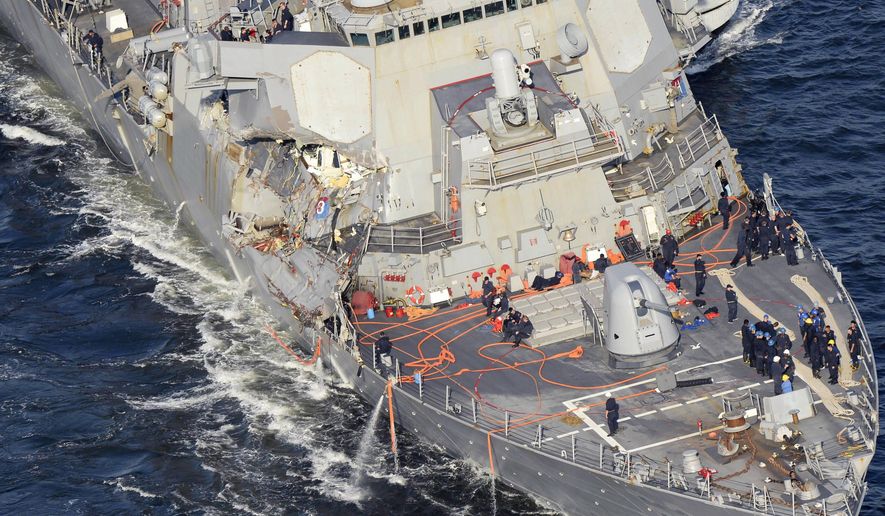The Navy has identified deep deficiencies in seamanship among its junior officers, with just 27 of 164 first-tour officers passing competency checks with “no concerns,” according to an internal review obtained Wednesday by The Washington Times.
The study was ordered after two naval collisions claimed the lives of 17 sailors last year and put the Navy in the spotlight.
Both maritime disasters, the Navy concluded, were avoidable and stemmed from failures of leadership aboard both vessels.
In the internal message, written by Vice Adm. Richard Brown, commander of Naval Surface Force Pacific, the Navy identified concerns with 137 of 164 junior officers who were randomly tested. The review found “some concerns” with 108 and “significant concerns” with the seamanship skills of 29.
Specifically, the review found issues with officers’ operation of radar and their ability to apply naval “rules of the road,” especially during times of low visibility.
The study also found that while most of the 164 officers were able to steer clear of near-collision situations, those who found themselves in harm’s way were often unable to take the immediate action necessary to avoid hitting another vessel. The failure to navigate through dangerous situations was a major factor in both fatal naval collisions last year.
Navy officials said the tests, which were conducted by the Surface Warfare Officers School from January through March, confirmed a need for improvement, but they expressed overall confidence in the officers steering U.S. vessels.
“So, out of 164 what we ended up seeing was kind of what we expected: We got a bell curve distribution. We had 27 who were on top, we had 108 who were in the middle and we had 29 who were kind of at the lower end,” Adm. Brown told Defense News, which first reported the internal survey. “We want to make sure the changes we are making are actually having an impact in the fleet and if we are increasing the level of experience and performance. … We want to move that bell curve to the right.”
The information gained through the reviews, Navy officials said, will be used to guide training programs moving forward.
While the internal message written by Adm. Brown didn’t directly address either of the fatal collisions, those incidents have cast a shadow over the Navy and the competency of its officers.
In June 2017, the Navy destroyer USS Fitzgerald struck a container ship off the coast of Japan, killing seven sailors on board. The ship was carrying a crew of nearly 300 sailors.
Just two months later, the USS John S. McCain collided with a Liberian-flagged merchant ship off the coast of Singapore, killing 10 sailors.
While the circumstances of each case were different, Navy officials said both could have been avoided.
“Both of these accidents were preventable and the respective investigations found multiple failures by watch standers that contributed to the incidents,” Chief of Naval Operations Adm. John Richardson said in a statement following an investigation. “We are a Navy that learns from mistakes and the Navy is firmly committed to doing everything possible to prevent an accident like this from happening again. We must never allow an accident like this to take the lives of such magnificent young sailors and inflict such painful grief on their families and the nation.”
Navy officials said the Fitzgerald crash resulted from ship leaders’ failure to follow “sound navigational practices.” In the case of the McCain, the Navy concluded that there was a “sub-standard level of knowledge regarding the operation of the ship control console.”
Navy leaders have vowed to improve, and Adm. Brown’s internal memo says progress has been made.
Key Senate Republicans introduced legislation this year as part of the broader National Defense Authorization Act that would reform naval practices and specifically address some of the concerns with training and competence laid out in the internal memo.
The Surface Warfare Enhancement Act, sponsored by Republican Sens. John McCain of Arizona and Roger F. Wicker of Mississippi, would, among other things, set “minimum at-sea and simulator-based training requirements to qualify for critical positions on the ships.”
“In the wake of the tragic accidents involving the USS Fitzgerald and USS McCain, our commanders and sailors have been calling for meaningful reform,” Mr. Wicker said this year. “Overextended and undermanned ships, overworked crews, fewer officers with naval mastery and confusing chains of command have contributed to a decline in our naval power.”
In the short term, Adm. Brown laid out immediate actions to address specific problems exposed by the review.
On the operation of radar, he said, he will push for additional money to add two more weeks of radar training for junior officers.
On dealing with near-crash scenarios, he said, the Surface Warfare Officers School is partnering with Naval Station Norfolk to develop extreme-extraction training designed to reduce or eliminate decision paralysis among junior officers.
• Ben Wolfgang can be reached at bwolfgang@washingtontimes.com.




Please read our comment policy before commenting.